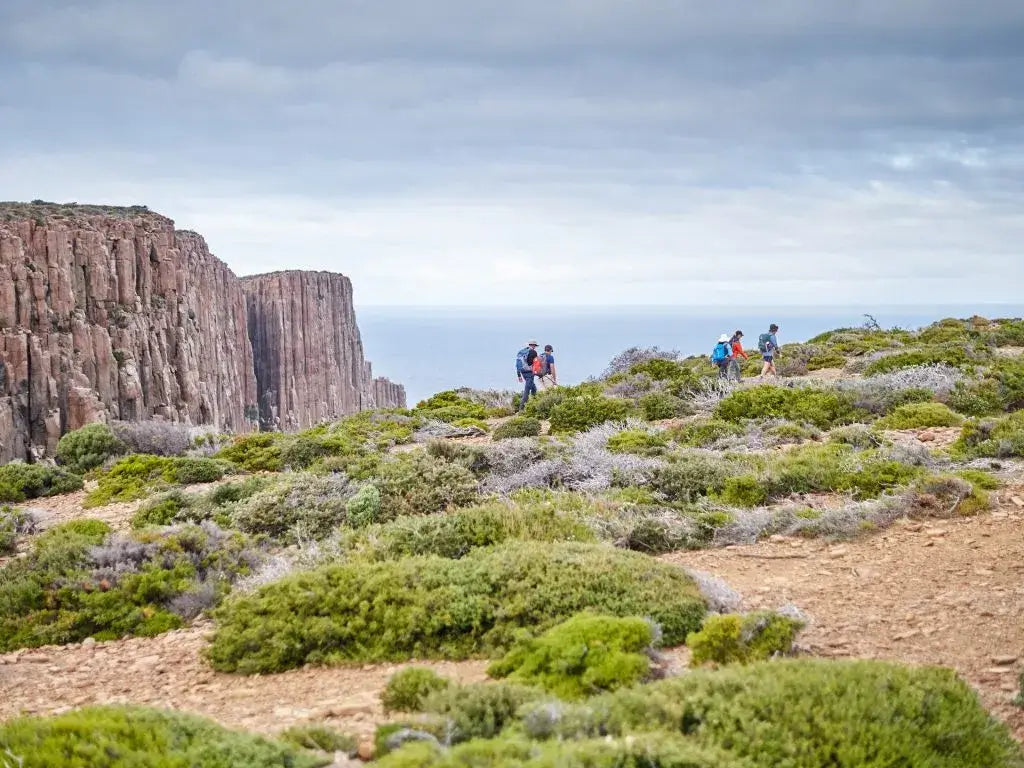Guided vs Self-Guided on the Three Capes: Costs, Comfort & What’s Included
Short version: both deliver jaw-drop cliffs and sea-eagle skies. Guided takes the admin and guesswork off your plate; self-guided trades support for freedom. Pick the format that matches your style, comfort needs, and calendar—then lock dates.
The 60-Second Cheat Sheet
-
Go Guided if you want: logistics sorted, expert interpretation, safety net, and a ready-made trail crew.
-
Go Self-Guided if you want: full control of pace, more solitude, and a DIY approach to food and logistics.
-
Either way: book early for peak windows and shoulder seasons; Tasman Peninsula is popular for good reason.
What “Guided” Usually Means (and Why People Love It)
-
Logistics handled: transfers, daily route briefings, timing around weather, and smart contingency planning.
-
Comfort dialled in: well-chosen accommodation and meal plans; recovery is easier when someone else cooks.
-
Local know-how: geology, ecology, and cultural context add depth—you don’t just see it, you understand it.
-
Group energy: small teams help with pacing, photos, and motivation on blustery sections.
-
Who it suits: time-poor travellers, first-timers to Tassie, anyone who values a safety net.
Browse more walks in Trekking & Hiking or scan Australasian Adventures for alternatives if dates clash.
What “Self-Guided” Really Feels Like
-
Freedom first: choose your start times, linger at lookouts, chase golden hour as you please.
-
DIY logistics: you’ll handle permits/passes, food drops or hut meals (where relevant), and transfers.
-
Navigation & safety: well-marked trails still demand judgement with weather, daylight, and energy.
-
Who it suits: confident walkers who enjoy planning and don’t mind carrying a little extra responsibility.
Not sure which style fits? Try the Find Your Adventure Style quick-fit quiz; it’s a fast way to match comfort and pacing preferences.
Inclusions: A Simple Side-by-Side
| Topic | Guided | Self-Guided |
|---|---|---|
| Route planning | Professionally planned daily stages | You plan stages & contingencies |
| Accommodation | Pre-arranged per operator style | You secure huts/lodges per availability |
| Meals | Often included or part-included | You shop/prepare or pre-arrange huts |
| Bags & transfers | Usually included/available | You arrange transfers or go fully self-carry |
| Safety net | Guide judgment + comms | Your responsibility; carry comms/PLB |
| Interpretation | Natural/cultural insights en route | Self-researched (or guidebook) |
| Flexibility | Moderate (group rhythm) | High (your timetable) |
Always check the specific tour page for exact inclusions and daily distances; details vary by operator and season. For a broader look at formats and regions, start with All Tours.
Comfort & Pace: What Changes Most
-
Recovery: Guided itineraries often mean better sleep and hot meals—energy you’ll feel on day three.
-
Pacing: Groups run at a steady, inclusive rhythm; self-guided lets you start pre-dawn or linger for photos.
-
Weather agility: Guides adjust start points and timing around wind and fronts; solo walkers should build buffer time.
Curious how booking here restores landscapes? The impact explainer lives at How It Happens.
Cost Drivers (Without the Guesswork)
-
What moves the needle: accommodation standard, baggage/vehicle support, guide ratio, seasonal demand, and transfers.
-
How to compare fairly: look at total trip value (meals, transfers, bag moves, parks fees) rather than per-day alone.
-
Good tactic: pick travel windows outside school holidays for sharper value and quieter viewpoints.
When to Go (Tasman Peninsula Rhythm)
-
Autumn (Mar–May): settled weather, crisp views, great shoulder-season feel.
-
Winter (Jun–Aug): quiet trails, dramatic light; pack extra warmth.
-
Spring (Sep–Nov): wildflowers and longer daylight.
-
Summer (Dec–Feb): warmer temps and popular dates—book early.
If flights or school calendars bottleneck your plans, browse other high-reward walks in Trekking & Hiking for the same style at different times.
Packing That Helps (Both Styles)
-
Footwear: grippy, broken-in hiking shoes/boots + spare laces
-
Clothing: breathable layers, sun shirt, warm mid-layer, light rain shell
-
Daypack: 20–30 L with hip belt; 2–3 L water capacity + electrolytes
-
Poles: knee-savers on rocky/steppy sections
-
Smalls: SPF 50+, zinc, lip balm, blister kit, headlamp, compact sit pad
-
Comms: PLB or satellite messenger for self-guided
Quick Decision Flow
-
Hate logistics? Pick a guided itinerary.
-
Love freedom and early starts? Self-guided.
-
Travelling with mixed abilities? Guided keeps the group steady.
-
Tight on time? Guided maximises days; self-guided demands a bit more planning margin.
-
Want deeper context? Guided interpretation adds meaning to every lookout.
Still split? Skim Australasian Adventures or try the Find Your Adventure Style quiz to nudge the decision.
FAQs
Is the track difficult?
Moderate: well-formed paths with some stairs and exposed lookouts. Weather can amplify the feel—wind and rain make cliffs more serious.
Do I need to be experienced?
Comfortable day-hikers do well on both formats. For self-guided, practice with a loaded daypack and poor-weather walks before you go.
Will my bag be moved?
Often yes on guided trips (or available as an add-on). Self-guided depends on the operator and your plan—check specifics before booking.
What about safety on cliffs?
Common-sense care: heed signage, keep to formed trails, and avoid edges in strong winds. Guided trips keep an eye on conditions and group spacing.
What’s the best month?
Shoulder seasons win for light and fewer people. Winter is stunning with the right layers.
Handy Links (for readers who skim)
-
Explore walks: Trekking & Hiking
-
Region hub: Australasian Adventures
-
All trips, one place: All Tours
-
Impact: How It Happens
-
Match your style: Find Your Adventure Style




